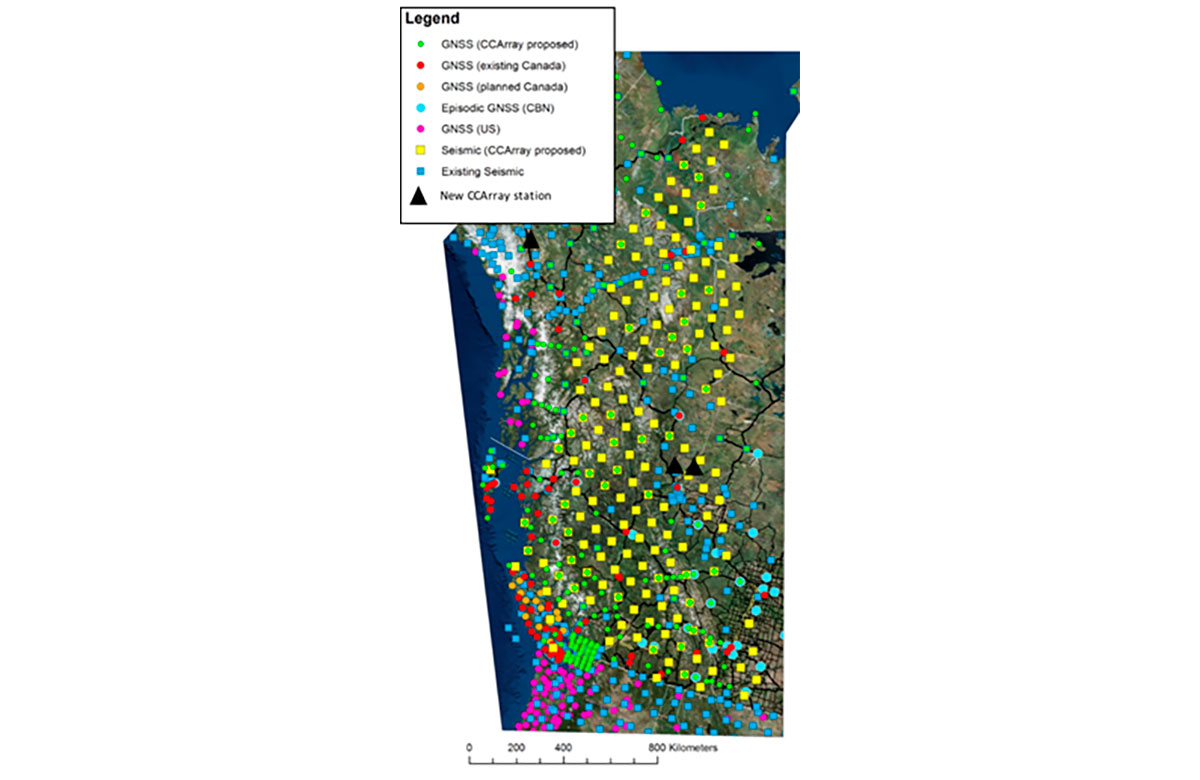CCArray and EON-ROSE: Emerging pan-Canadian Multidisciplinary Research Initiatives
The Canadian Cordillera - the mountainous regions of western Canada - represents a world-class natural laboratory for exploring the interconnected Earth systems that are critical to our understanding of major scientific grand challenges. The Canadian Cordillera Array (CCArray) is a proposed international scientific initiative, spearheaded by the creation of a tectonic plate-boundary scale, open-data observational network, that will enable trans-disciplinary research focused on Earth systems processes and boundaries - from Earth’s core to the magnetosphere. During the past few years, regional and national workshops have been held to define high-level scientific targets and geographical regions for a CCArray network in western Canada, capitalizing on anticipated domestic and international opportunities for instrumentation, operations and funding. CCArray is highly ambitious, but it represents only the first stage in a proposed national initiative, EON-ROSE (Earth-System Observing Network/Réseau d’Observation du Système terrestrE). This article provides a brief introduction to the scientific vision and objectives of CCArray and EON-ROSE, together with information about the proposed infrastructure and some of the planned research themes. It concludes with a summary of the bright prospects for collaboration between academia, resource industries and governments, local communities and organizations outside of Canada.
CCArray and EON-ROSE will build upon the scientific momentum of previous Earth-systems research and data collection initiatives, such as Canada’s Lithoprobe program (1984 - 2004) and the EarthScope program in the U.S. (2004 - 2019). The aim is to understand and address urgent scientific grand challenges, including the search for natural resources to accommodate the needs of Earth’s increasing population, mitigating natural and anthropogenic hazards and their negative impacts, and becoming environmental stewards in response to global change (NRC, 2012). To better understand and address these challenges, foundational elements of CCArray and EON-ROSE will include installation of a synoptic network of autonomous, real-time, telemetered observatories, and the establishment of an international, transdisciplinary network of Earth science researchers and research institutions. In the case of CCArray, the envisioned instrument distribution depicted in Figure 1, based on a nominal 85-km grid. Such a network will be highly enabling for a number of key techniques and outcomes that include the use of modern seismological imaging algorithms using passive seismic sources including ambient noise, achieving a relatively homogeneous characterization of natural and anthropogenic hazards, atmospheric and space weather monitoring. The core of the network instrumentation will be broadband seismometers and Global Navigation Satellite System (GNSS) equipment. This infrastructure will provide the backbone for other proposed sensors at selected sites, including relative and absolute gravimeters, atmospheric, meteorological and magnetotelluric systems.
Broadband seismometers record ground motion over a much wider range of frequencies than the bandwidth for seismic exploration, often as low 0.01 Hz (100s period) or lower. The wide frequency range is essential to capture the full range of radiated wave energy from earthquake sources. Figure 2 shows the design for a recently installed broadband seismograph station near Fort St. John, B.C., which represents one of three new stations that have recently been installed as part of CCArray.
Research objectives for CCArray and EON-ROSE that are especially pertinent to geophysics include improving our understanding of Earth structure, tectonics, earthquake occurrence and seismic hazard, glacial isostatic adjustment, induced and triggered seismicity, and determining vertical land motion for robust relative sea-level projections. Other research activities will include the establishment of a network of new Critical Zone Observatories (CZOs) (e.g., Shi et al., 2013) to enable investigation of the wide-ranging ecosystems across Canada. These CZOs will help to establish an environmental baseline to facilitate investigation of wide-ranging ecosystems across Canada, such as mountain glacier change and permafrost dynamics. While Canada currently has some partial CZOs at many university research stations, there are no formally established complete Critical Zone Observatories (Martin and Johnson, 2017). Collectively, these research themes, together with the “big data” that will be acquired as part of CCArray and EON-ROSE initiatives, will furnish unique multidisciplinary platforms for training the next generation of highly qualified personnel in topics ranging from machine learning to tectonics. Education-outreach-communication programs will likewise form an integral component of both of these initiatives through extensive consultation, primarily with rural First Nations communities and the general public.






